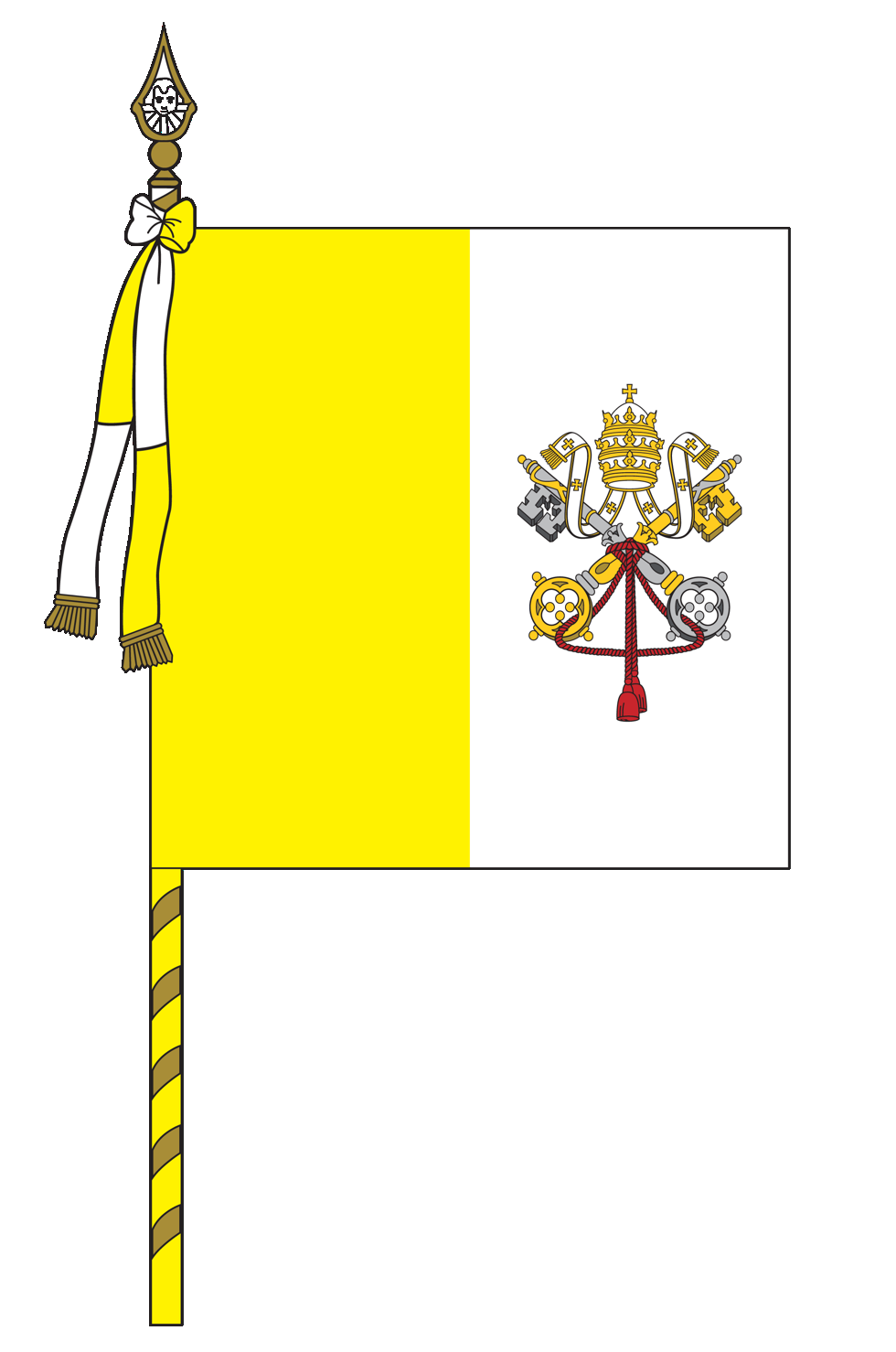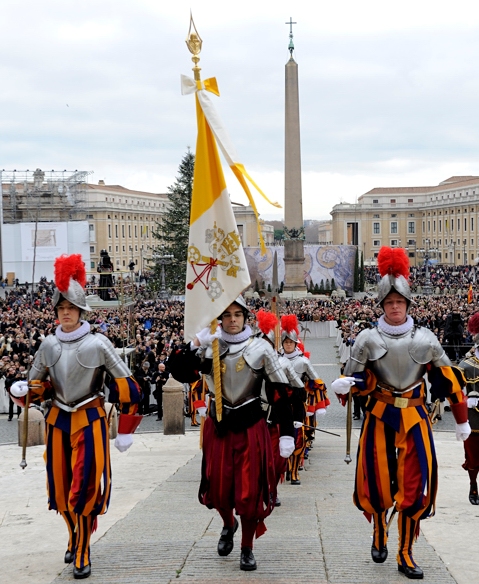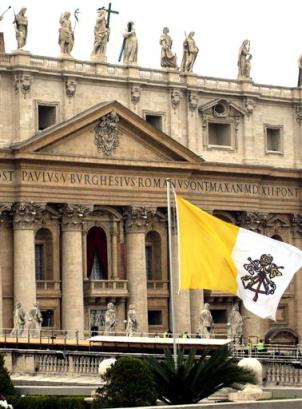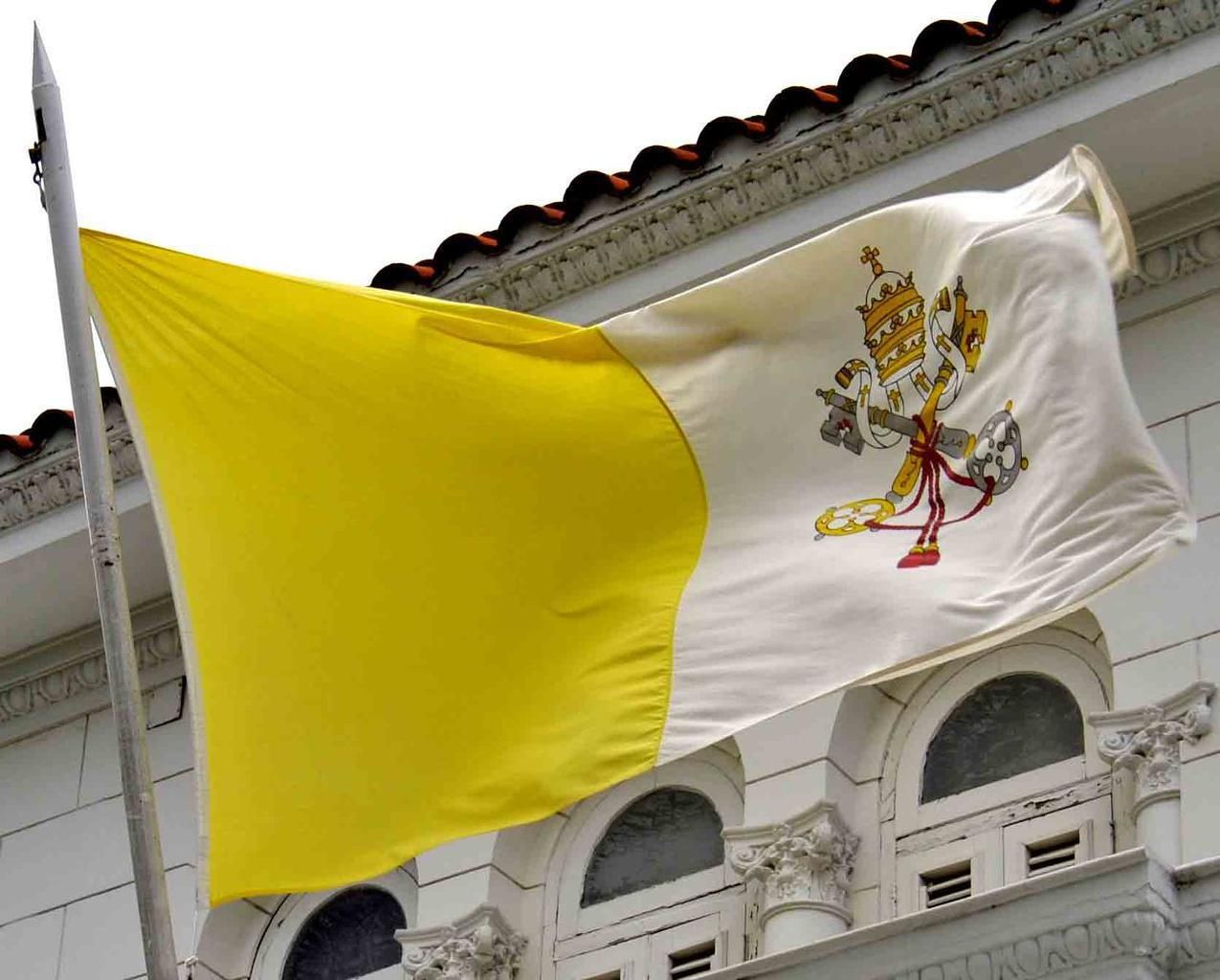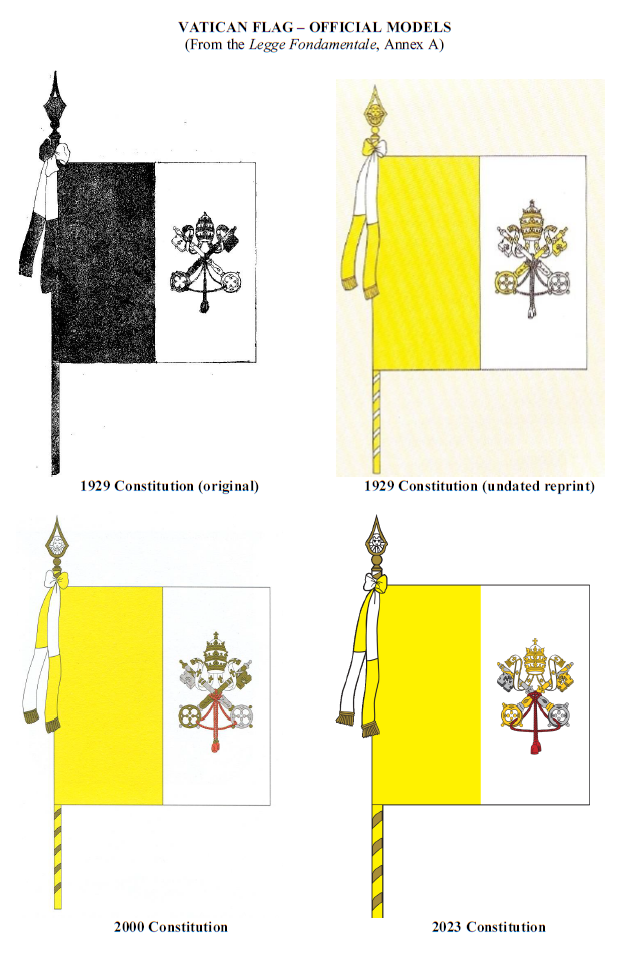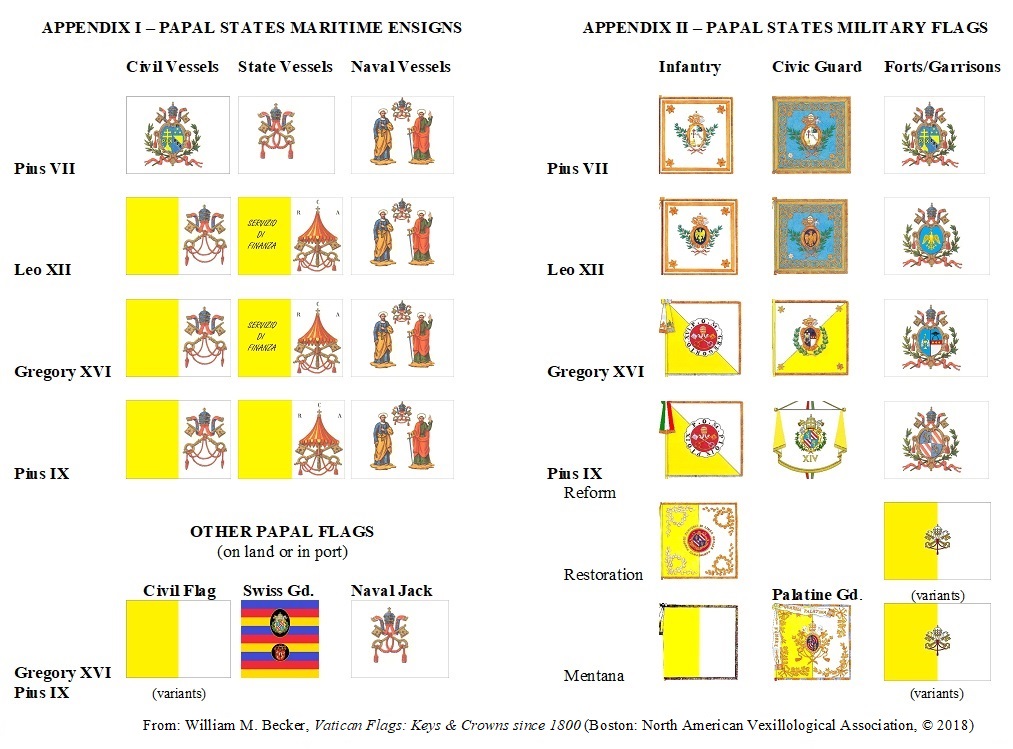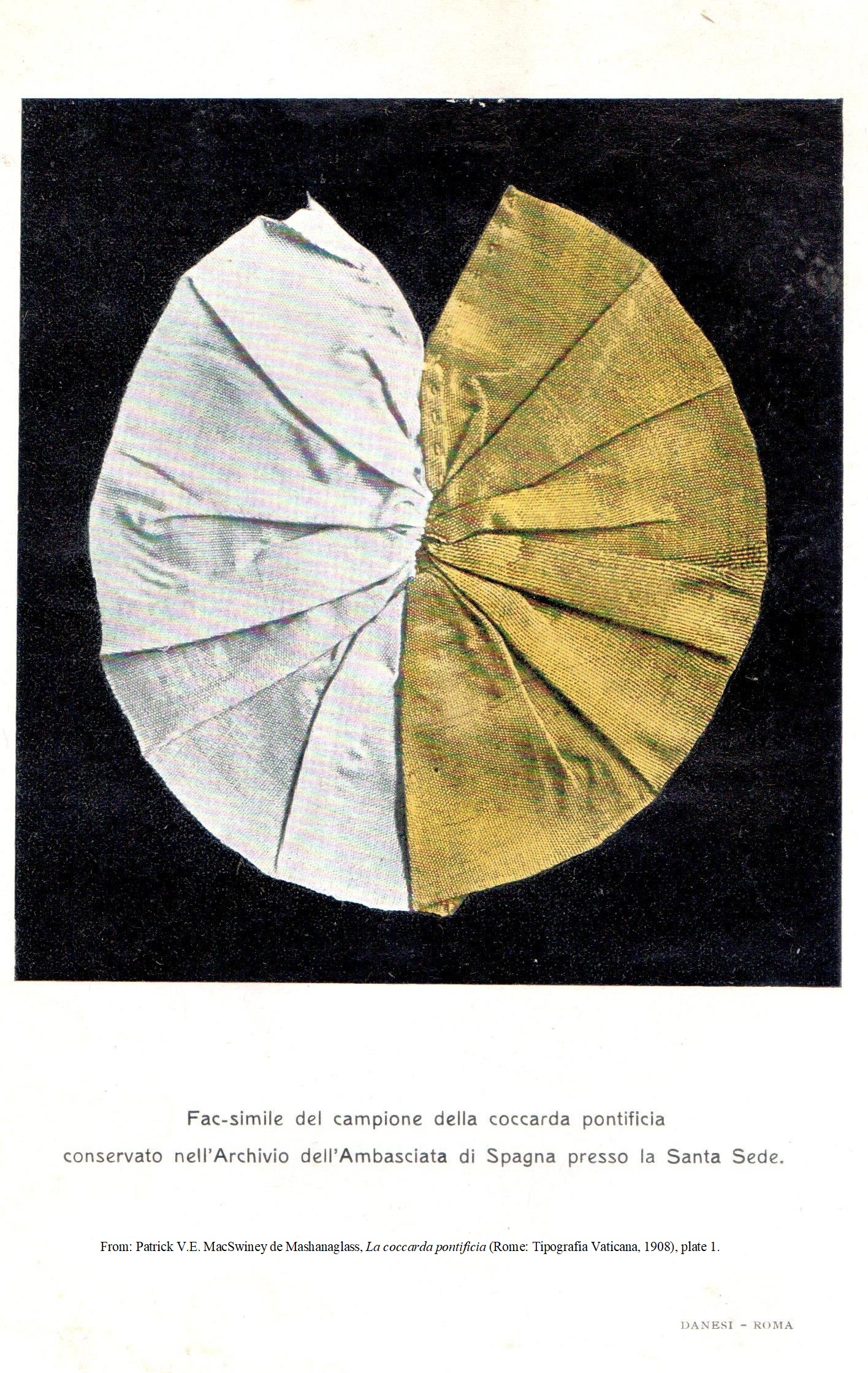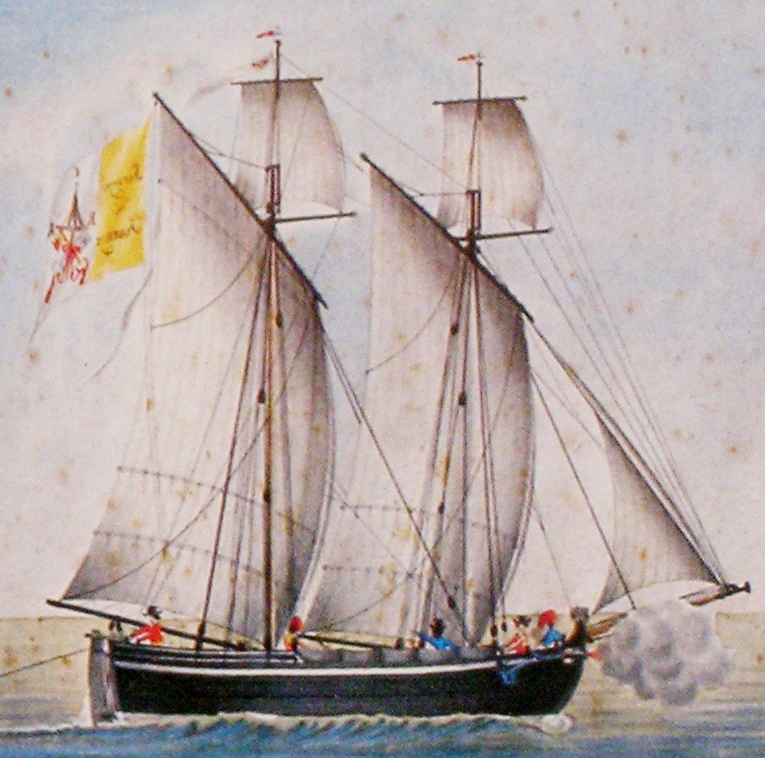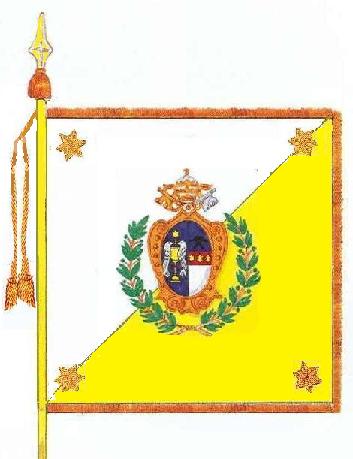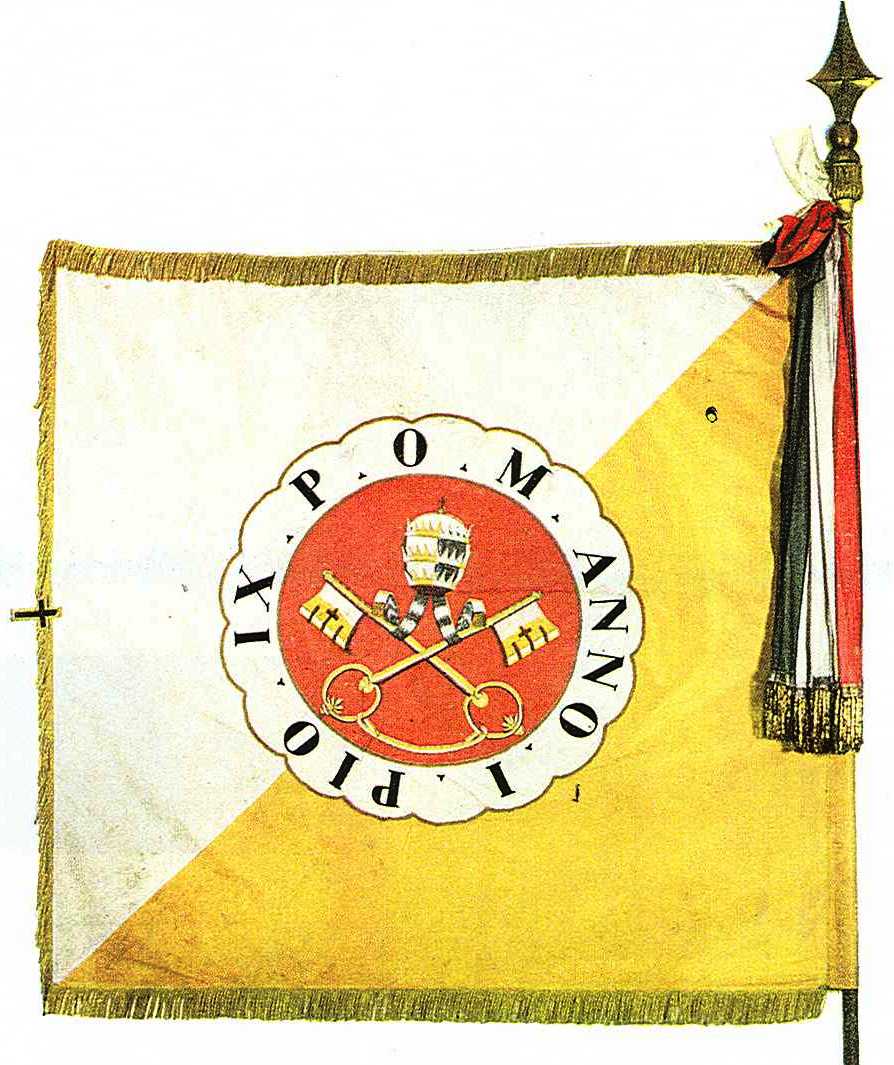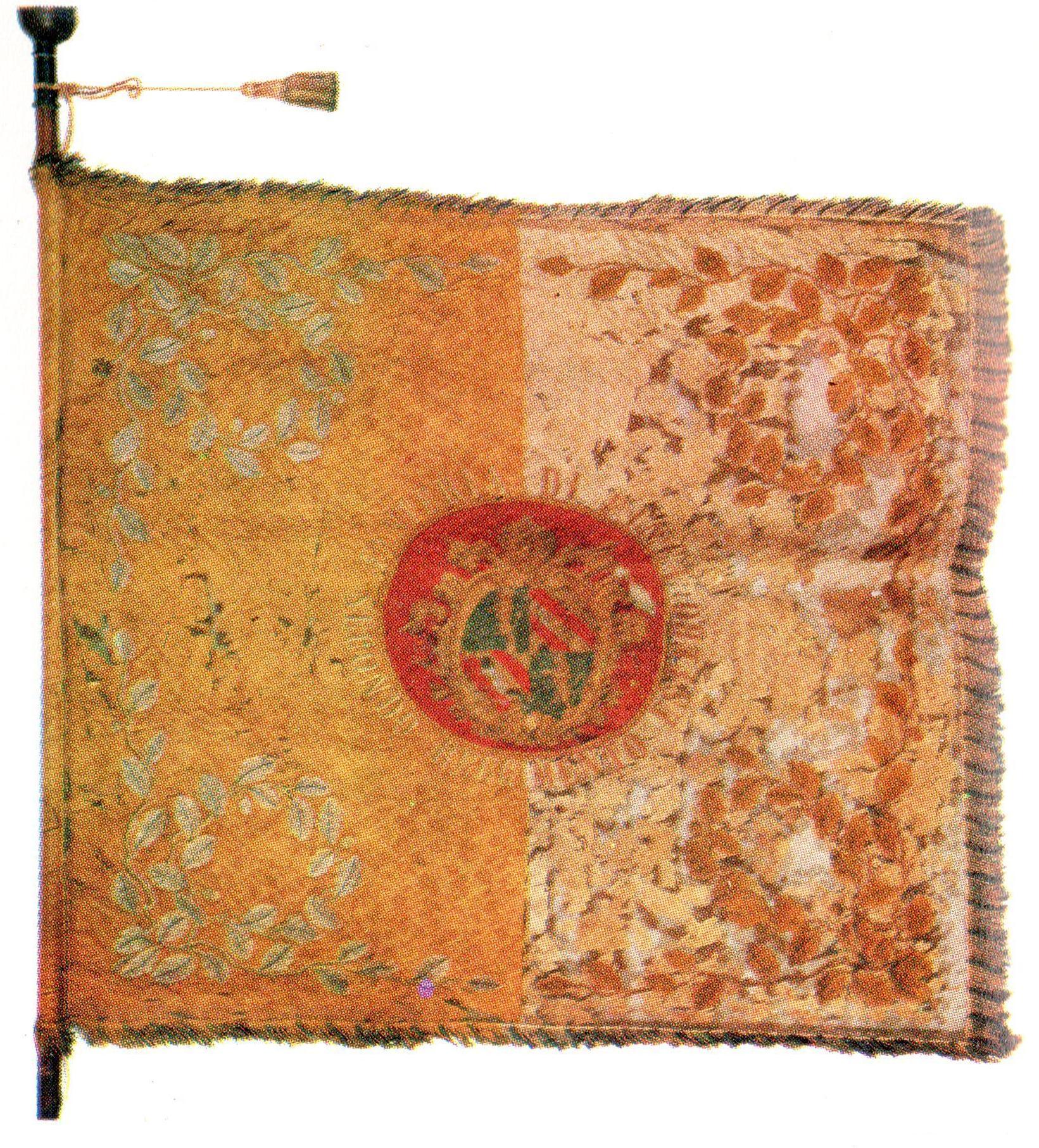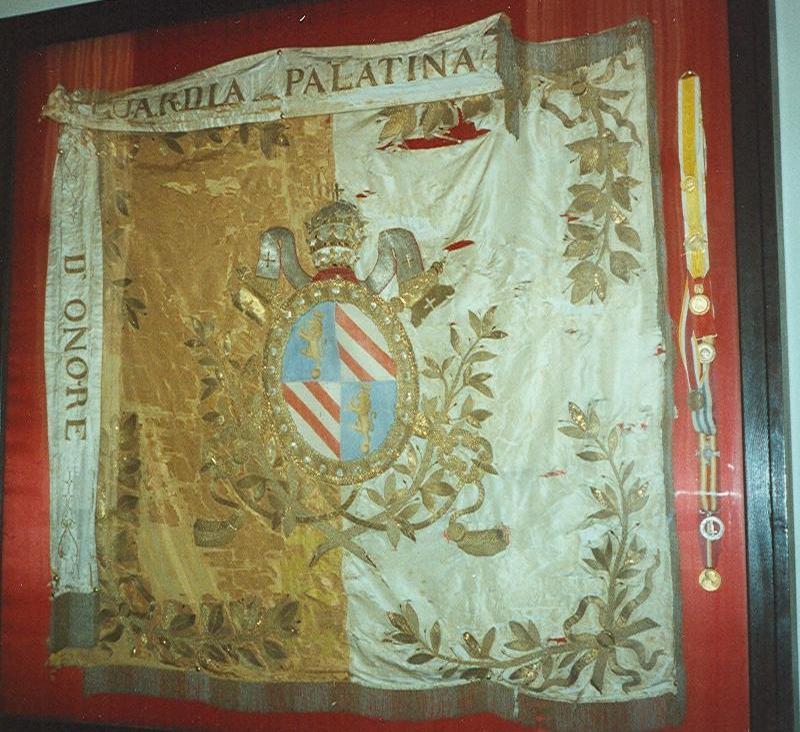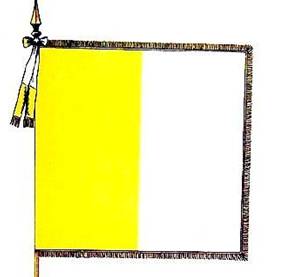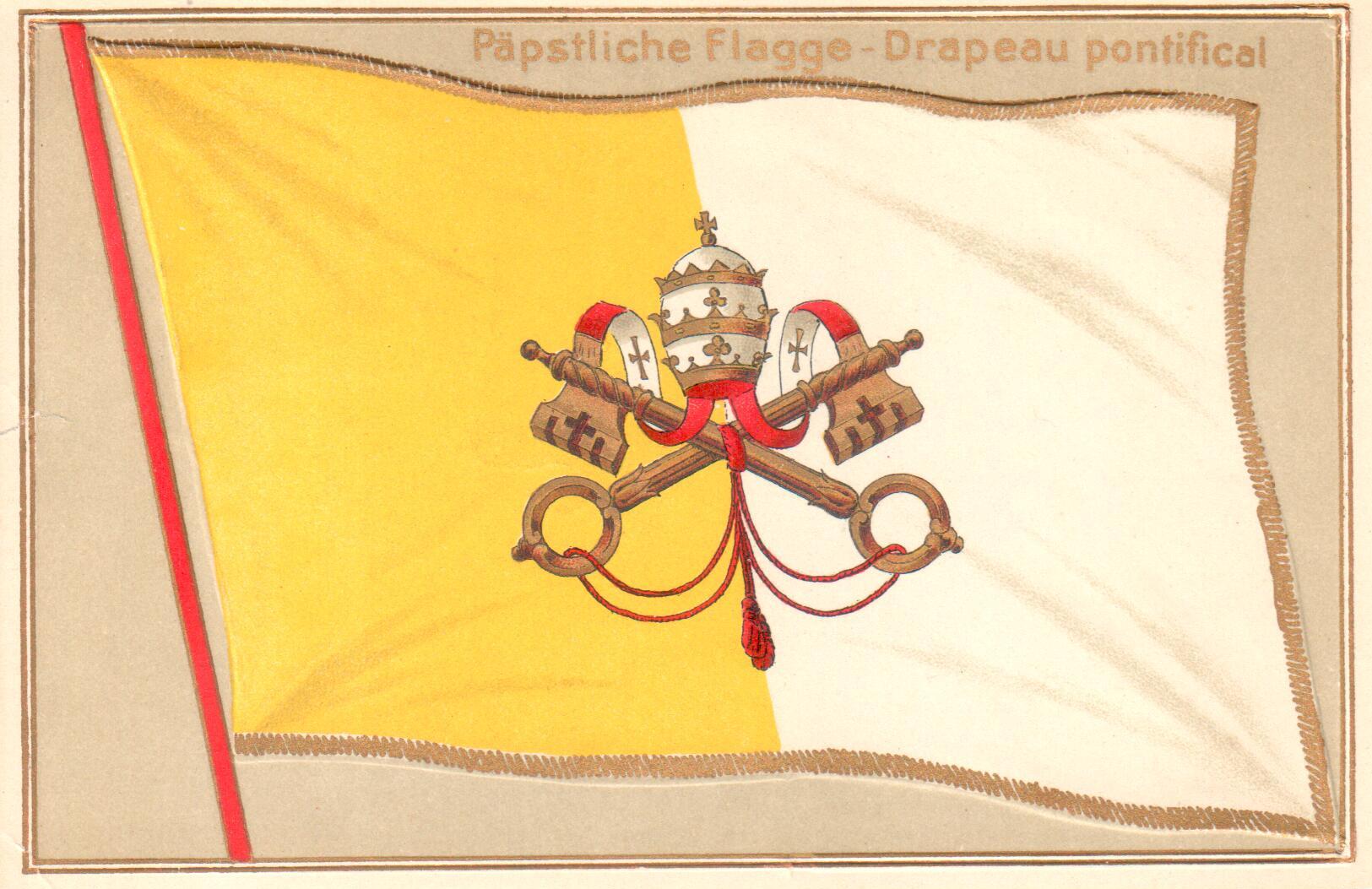Fig. 1.1 – Vatican flag (2023 constitution, annex A)
Fig. 1.2 – Vatican ceremonial flag, 2012
Fig. 1.3 – Vatican flag, Apostolic Palace, 2017
Fig. 1.4 – Vatican flag, Palazzo delle Congregazioni
(Extraterritorial Zone, ca. 2019)
Fig. 1.5 – Vatican flag & St. Peter's Basilica, 2016
(Residenza Paolo VI, Extraterritorial Zone)
Fig. 1.6 – Vatican flag & St. Peter's Basilica, 2005
(Residenza Paolo VI, Extraterritorial Zone)
Fig. 1.7 – Vatican flag, Governorate, 1938
Fig. 1.8 – Vatican flag, Nunciature to CubaTHE FLAG
of
VATICAN CITY
Description & Symbolism
The flag of Vatican City State is divided vertically into two equal stripes, yellow (at the hoist) and white (at the fly). The white stripe bears the traditional papal emblem, the crossed keys of St. Peter beneath the papal tiara. It is commonly called the “papal flag” (Italian, bandiera pontificia), and was adopted on June 7, 1929, in the state constitution. It was first flown by Papal States merchant ships from 1825-1870.
Yellow and white have been the papal colors since 1808 when they were first used in a cockade, i.e. a circular cloth badge. The keys of St. Peter, crossed diagonally, have symbolized the papacy's spiritual mission since the middle ages. They are referenced in the New Testament, in the words of Jesus to Simon: “I will give you the keys of the kingdom of heaven. Whatever you bind on earth shall be bound in heaven; and whatever you loose on earth shall be loosed in heaven” (Matthew 16:19). The triple tiara has symbolized papal temporal sovereignty for centuries, as well.1
Design & Use
The Vatican City flag design is specified in its constitution, with an annex that provides an illustration. The latter has changed only slightly in successive versions of the constitution. It portrays a ceremonial flag with square dimensions, and a special staff, finial, and cravat. This ceremonial flag is carried by the Pontifical Swiss Guard akin to an infantry color.2
Apart from the ceremonial flag, the constitution does not explicitly specify proportions for state flags displayed on official buildings; and in actual practice at the Vatican, they are currently oblong, in the same proportions as those of Italy’s flag (2:3). However, in decades past, square state flags were often seen. Minor variations in other design details have also been common over the years.3
The Vatican flag is flown on occasions specified by the Pontifical Commission for Vatican City State, its legislative body, including papal anniversaries and Roman Catholic religious feast days. Upon a sitting pope’s death, it flies at half-staff until the novemdiales is completed (the nine-day mourning period following his funeral).
Beyond Vatican City, its flag also flies at 17 zones of the Holy See, in and near Rome, which enjoy extraterritorial immunity according to the Lateran Treaty of 1929 and subsequent agreements. It also flies at diplomatic missions of the Holy See, especially its Apostolic Nunciatures (papal embassies).4 Roman Catholics throughout the world often use the Vatican flag to express Catholic identity at churches, educational institutions, and other establishments.
History of the Vatican Flag
The current papal flag originated in the Papal States, where it was introduced for merchant and fishing vessels on September 17, 1825.5 It was used until the Papal States disappeared in 1870, but not on land; and it was not the only papal flag. Other flag designs were used by Papal States militias, forts, armed vessels, or by the general public. Many of these flags are preserved in museum deposits or are attested in contemporary art.
Authorized papal flags often changed with each new pope. Until the seventeenth century, they often had red fields bearing papal emblems. From the seventeenth through the nineteenth centuries, they usually had white fields (like the French royal standard) charged with various papal symbols. In the 1800s, yellow-and-white flags began to appear, and grew in frequency.6
These colors were based on a yellow-and-white papal cockade first introduced by Pius VII on 13 March 1808 for papal troops and diplomats who remained loyal to the pope and who opposed the occupation of the Papal States by Napoleon.7 He abolished it and exiled the pope; but it was resurrected after Napoleon’s downfall and the restoration of the Papal States in 1814-1815.
In 1825, the first yellow-and-white flags were introduced for various maritime purposes, but the navy retained its old white designs. On land assorted yellow-white flags were soon employed by the Civic Guard (1831-1848) and the papal infantry (ca. 1831-1870). By mid-century various yellow-white flags were used by private citizens, some state fortresses (from at least 1849), and the Palatine Guard (from 1859). Their designs changed periodically and usually bore various papal emblems, but the final papal infantry color was a plain yellow-white flag with no emblem (1862-1870).8
The same flag design – a plain yellow-white vertical bicolor – flew from Castel Sant’Angelo, the major papal fortress in Rome, upon its seizure by Italian forces in September 1870. It is preserved by the Vatican Historical Museum.9 A similar flag, but with the tiara-keys emblem bisecting the stripes, flew in 1870 at Rome’s Porta Pia fortifications, and is also held by the Vatican.10
The latter two designs remained in use by various papal loyalists during the Roman Question period (1870-1929) which followed the fall of Rome until the creation of Vatican City. The one with the emblem served as the proto-national papal flag at the Vatican and related offices.11
The papal colors and emblem
The yellow-white papal cockade of 1808 was probably based on the traditional colors of the keys of St. Peter, gold and silver. In heraldry these colors translate as yellow and white, especially when rendered in cloth. As early as the middle ages, Dante Alighieri describes the keys of the kingdom as gold and silver, or as yellow and white.12
The previous Roman cockade, adopted in 1800, was red and yellow.13 This, too, may have been a reflection of the Petrine keys, since medieval papal banners were often red with golden emblems, such as the crossed keys. The modern civic flag of Rome is also red and yellow; or more specifically, a vertical bicolor of maroon and golden-yellow. However, this flag was not used in the Papal States.
When placed on a red shield, the tiara-keys emblem forms the coat-of-arms of Vatican City State; but when the emblem appears alone, it more properly represents the Holy See. The Vatican website shows both of these insignia with the gold key-handle on the heraldic dexter (i.e., the observer’s left). However, the juxtaposition of the keys is reversed in the personal coat-of-arms of the pontiff.14
For several centuries, popes have used the tiara-keys emblem as heraldic “supporters” for their own personal armorial shield. However, the last pope to wear an actual tiara was Paul VI, and recent popes have replaced it with a miter in their pontifical arms.15
Pontifical Swiss Guard
The flag of the Pontifical Swiss Guard Corps is displayed on special occasions, including the swearing-in of new recruits. Its basic pattern was approved by the Secretariat of State on November 1, 1913, and bears features drawn from previous Guard flags. It is square with a large white cross reminiscent of Swiss military flags in centuries past. At the center appears the commander’s coat-of-arms within a floral wreath. Two of the flag’s resulting quarters bear the current papal arms juxtaposed with those of the Guards’ founder, Pope Julius II, against a red background. The remaining quarters bear stripes in the Guards’ colors, red-gold-blue. These recall the armorial colors of Pope Clement VII de’Medici, rescued by the Guard at great sacrifice during the sack of Rome in 1527.16
Papal Flags – Summary Chart (1800-1870)
Fig. 2.1 – Papal States civil ensign, 1825-1870
Fig. 2.2 – Papal Cockade, 1808
(Spanish Embassy to the Holy See)
Fig. 2.3 – State Ensign, Papal Coast Guard, 1830
(detail, Museo Civico Navale, Genova-Pegli)
Fig. 2.4 – Papal States, Rome Civic Guard flag
1831-ca. 1841 (arms of Gregory XVI)
Fig. 2.5 – Papal States Infantry Color
1846-1849; pattern ca. 1831-1849
Fig. 2.6 – Papal States Infantry color
ca. 1850-1860 (arms of Pius IX)
Fig. 2.7 – Palatine Guard color, 1859-1878
(arms of Pius IX); pattern until 1970
Fig. 2.8 – Papal States Infantry Color, 1862-1870
Fig. 2.9 – Papal States War/Fort flag, Rome, 1870
(Porta Pia fortifications)
Fig. 2.10 – Proto-National Papal Flag, ca. 1910
